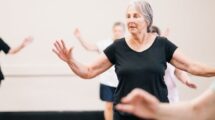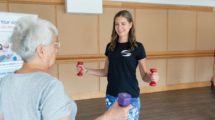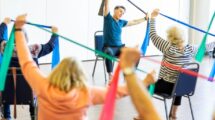
By Catherine Morisset
Staying fit strategies to keep you moving
In the winter months, many people fall into pseudo- hibernation — they switch from summer’s activities to a very sedentary life that lasts for six to eight months, pretending that exercising sporadically four months of the year will get them all the health benefits they need. Get real! This only makes sense if you are programmed to also stop eating and to sleep through winter.
Hibernating excuses
The excuses I hear for hibernation are usually the cold weather, the shorter days and the feeling that you have less energy. Of course, you’ll have less energy if you never go into sunlight and don’t move — and not moving also means you’ll have less energy.
Maybe you’re scared of falling and breaking something on the ice and snow? Well, of course it does get slippery and on those days, you can choose some of the activities described below. But what about changing your mental attitude, making it a priority for you to keep fit, no matter what the weather?
Fitness is about making movement a part of your regular lifestyle
Fitness is about the small decisions you make daily. Make fitness easier by making it part of your life — on the same level as brushing your teeth or taking a shower.
Get up and just DO something
So, get out of your chair — yes NOW. Stand up. Walk around your house or apartment three times. Sit down. There you go, you just started a fitness program. How long did it take? I’d say five minutes if your house is large and you were slow. Well, it’s not the Olympics, but being fit doesn’t have anything to do with pushing you to the edge of human performance. It’s about moving a little more, a little more often.
Three basic tips to get and stay fit, even in sub-zero temperatures:
1. Make fitness a priority
YES, you will move today, NOW in fact. Get up again, walk around your house three times (try going the other way for new scenery) or climb the stairs (if you have them) three times. Then you can sit down.
2. Find a time for your fitness activities
Make it mindless: what about Monday, Wednesday, Friday at 9:00 a.m.?
Start small with 15 minutes at a time.
As you get fit and bold in those 15 minutes, add to the duration, aiming for 30 minutes of continuous movement.
3. Do something — anything — to move during your fitness time
Walk around the house (you know the drill).
Climb the stairs.
Put good music on and dance wildly (close your curtains if you are uneasy about the neighbours).
Go for a short 15-minute walk outside (dress warmly).
Exercise ideas
When you are desperate to find something different
Do each exercise four to 10 times, building the number of repetitions gradually.
Breathe slowly and regularly.
NEVER hold your breath.
Do each exercise slowly; control is what counts (not speed).
Do the stretch indicated after each exercise to prevent muscle soreness.
Narrow squats — for legs, hips, back and balance
Stand in front of a sturdy chair, feet as wide as shoulders.
Slowly lower hips toward chair without touching it.
Back remains flat, with head in line with upper back, chest lifted.
Keep knees behind toes. Pause, then slowly come up.
Stretch: stand tall, raise right heel back and up so you hold onto your pant or ankle. Let right leg relax, feel front of thigh and hip stretch. Repeat with the other leg.
Standing back leg raise — for hips, back and hamstrings
Stand tall near a chair for balance, transfer weight over left leg.
Slowly raise right leg back and up, keeping it straight, release slowly.
Do the whole exercise very slowly; repeat with the other leg.
Stretch: sit on chair, extend left leg forward, heel on floor; lean forward at hips, keeping back flat, until you feel a stretch in the low back, hips and hamstrings. Repeat with the other leg.
Standing toe/heel raises — for calves, ankles, shins and balance
Stand near a sturdy chair for balance, holding on to chair as needed.
Slowly raise both heels off floor, pause, then release slowly.
Slowly raise toes off floor, pause, then release slowly.
Stretch: same as after #2, then point toes to floor.
Chair lean back — for abdominals, hips flexors and neck
Sit at the front edge of a sturdy chair, lift chest, back is flat, head neutral.
Feet as wide as hips, directly under knees; arms by your sides.
Slowly lean back until you feel abdominal muscles contracting, or even shaking.
Come forward slowly and repeat.
Stretch: same as after #1, then raise arms overhead and reach up.
Well, there you go. By the time summer rolls around again, you’ll be fit, healthy and have more energy to enjoy it — feeling younger this time, not older.
Catherine Morisset is a certified trainer with the Canadian Society of Exercise Physiology, the YMCA-YWCA and the Canadian Association of Fitness Professionals. She has a keen interest in helping older adults improve their level of fitness and health.






